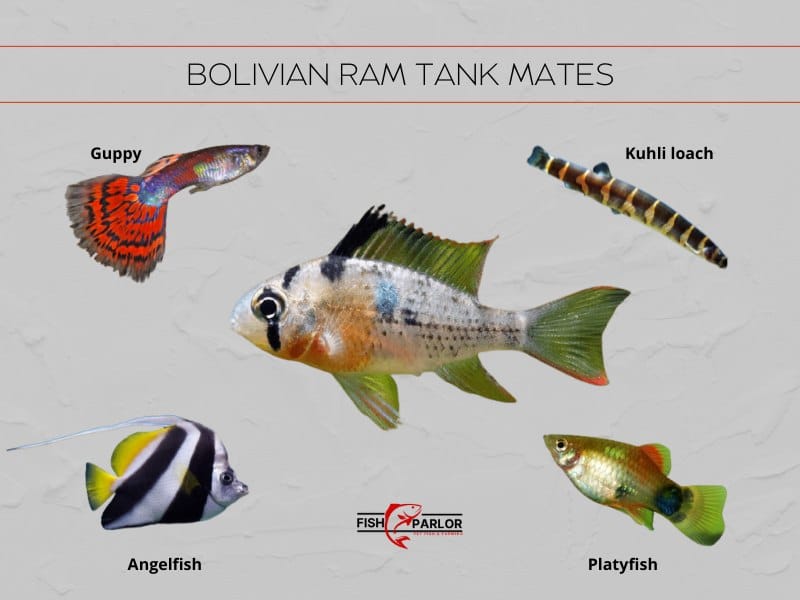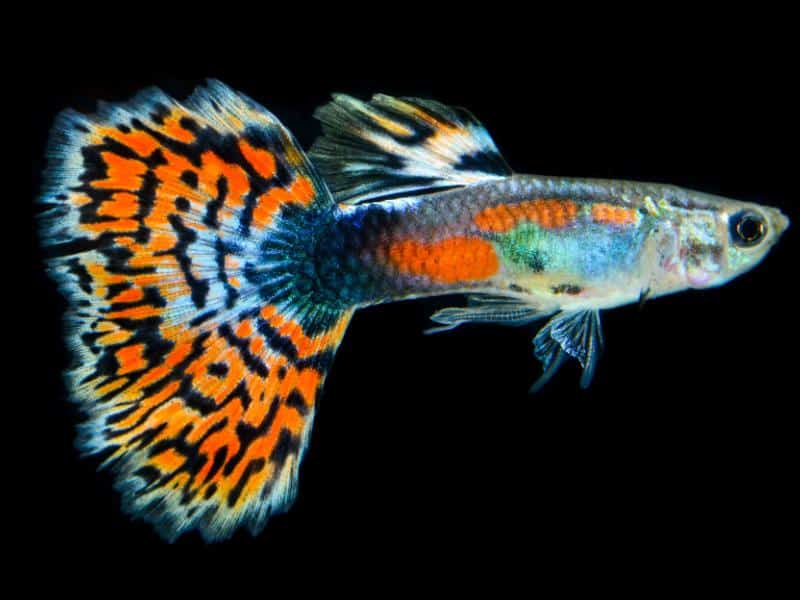The most aggressive fish toward Bolivian rams are big predatory fish that bully, chase, and dominate smaller fish. The wrong tank mates can cause significant stress to your Bolivian rams or even kill them. But what fish make good tank mates for Bolivian rams?
Bolivian rams can live comfortably with various other peaceful fish such as molly fish, platyfish, corydoras catfish, kuhli loaches, cherry barbs, angelfish, guppies, emperor tetra fish, dwarf gouramis, and silver dollar fish.
Below, I’ve discussed the ten best Bolivian ram tank mates and their primary care requirements to help keep your aquarium happy and healthy.

10 Best tank mates for Bolivian ram cichlids
As a rule of thumb, the best tank mates should be roughly the same size as Bolivian rams and have a peaceful temperament.
Bolivian rams are generally bottom feeders; top feeders make for the best Bolivian ram tank mates. They are gentle and graceful swimmers that thrive in aquariums that are at least 20 gallons in size. To add tank mates, increase the tank size to allow more space for the other fish species.
Here are the best tank mates for Bolivian ram cichlids:
Angelfish

Bolivian rams and angelfish are compatible tank mates. Both fish will live in the same aquarium without aggression and other problems. The rule of thumb for keeping these fish together is to add plants and decorations in your fish tank to give them more hiding caves to make them feel safe and reduce boredom.
Angelfish grow to two or three times the size of Bolivian rams and require a lot of swimming space. To keep angelfish and Bolivian rams together, use a minimum tank size of 55 gallons. A water temperature between 72°F and 79°F will accommodate them perfectly.
Cherry Barbs

Cherry barbs are as mild and peaceful as Bolivian rams. However, they are fast swimmers compared to Bolivian rams. Whereas you can keep one Bolivian ram, Cherry Barbs thrive in groups of six or more.
A slightly acidic or neutral water pH of 6 to 7 with plenty of plants will keep them active and resistant to particular diseases. You, therefore, want to keep that in check using aquarium test kits.
Although they are both peaceful, the fish also need hiding spots for refuge.
Use driftwood, rocks, and foliage to create hiding spots for Bolivian rams and cherry barbs. To keep them in the same aquarium, ensure slow-flowing water and partial light.
Corydoras catfish

Bolivian rams and corydoras catfish do not pay attention to each other in the tank. If you keep them in pairs or groups, the fish will be busy with their species.
Bolivian rams will chase after themselves, same as the Corydoras. However, Bolivian rams occasionally attack the cory cats when the ram cichlids are spawning. But it is nothing to worry about because the fish will not cause any significant damage or stress to each other.
Keep them together in a 30-gallon tank or bigger so they can graze far from each other and understand one another’s territory.
Dwarf gourami

You should not keep one dwarf gourami. They are social and peaceful fish species that do well in groups of four to eight. A fully grown dwarf gourami is about 3.5 inches in length, almost equal to the size of Bolivian rams.
They are compatible with each other because they have different swimming habits. Dwarf gouramis are top dwellers, and Bolivian rams are bottom feeders. They are very compatible with one another.
Feed them daily with frozen food, including brine shrimps, blood worms, white worms, and daphnia. With proper care and tank maintenance practices, dwarf gouramis and Bolivian rams can live for over four years.
Emperor tetra

Empire tetras are peaceful and get along pretty well with most non-aggressive fish such as Bolivian rams. Empire tetras tend to be middle and top aquarium dwellers. But they will occasionally swim to the bottom of the tank.
A water temperature between 72 and 82 degrees Fahrenheit is essential to keep emperor tetras with Bolivian rams. Keep them in a fish tank larger than 30 gallons and add carpet and midground aquarium plants such as Anubias and Anachris for oxygen circulation and absorption of CO2 and ammonia.
Guppies

Guppies will get along with Bolivian rams just fine because they’re peaceful fish that will mind their business in a community tank. You should keep a pair of Bolivian rams in a 20-gallon tank and at least five gallons for every additional tank mate.
See more guidelines on guppy tank size here.
Guppies and ram cichlids appreciate hiding spaces and territories. Use aquarium plants, rocks, ornaments, or driftwood to provide them with hiding places. Both fish are also active swimmers in random directions. They are exceptionally playful and beautiful to watch.
Kuhli loaches

Kuhli loaches are tiny and exciting freshwater fish that will coexist with many peaceful species, including the Bolivian rams. Kuhli loaches are bottom feeders and omnivores who will eat plant-based materials and meaty products.
Any substrate you put inside the tank should be soft and smooth to protect the underbelly of the kuhli loaches from cuts and abrasion. With regular tank maintenance, feeding, and water changes, your kuhli loach will outlive the Bolivian rams.
Keep them together in a 20-gallon tank or larger, and plant java fern or moss to create shade and hiding places for your fish.
Platyfish

Platyfish is also a compatible tank mate to the Bolivian ram. Platyfish are not only amiable fish, but they can also tolerate a wide range of water conditions. The male platies usually display some sort of aggression to each other but not to the Bolivian rams.
Although platies are not considered schooling fish, they will appreciate it if you keep them in groups of three to six. They are mid aquarium dwellers and active swimmers. Keep them with your Bolivian rams in a larger tank, preferably a 50- to 75-gallon tank.
Rummy nose tetras

Rummy nose tetras are noticeable by their bright-red heads. They have a slender profile and are thus smaller than Bolivian rams. Rummy nose tetras have a peaceful temperament like every other fish we have seen in this article.
Caring for the Bolivian rams and rummy nose tetras is not tricky. Ensure five gallons for every fish in your aquarium. Grow plants and add sand and ornaments. Most importantly, change the aquarium water once or twice weekly to keep your fish healthy and happy.
Silver dollar fish

Silver dollars are beautiful tropical fish belonging to the family Characidae. They grow to about 6 inches and are semi-aggressive. You can keep them with any fish that do not fit into their mouths, such as Bolivian ram fry.
A larger tank of about 75 gallons is recommended for keeping silver dollar fish and Bolivian rams. Unlike the Bolivian cichlids, silver dollar fish are prolific plant-eaters.
To keep them together, use hardier varieties of live plants in your aquarium or stick to plastic plants.
Can you keep one Bolivian ram cichlid?
You can keep one Bolivian ram cichlid because they are neither schooling nor shoaling fish. Although a Bolivian ram can do well alone, keeping a pair or a group of fish is good.
It is recommended to keep males alone to avoid occasional fights over females. Although the males can show slight aggression, they are usually harmless to one another and other fish.
But if you want to breed Bolivian rams, keep a group of four to eight and allow them to pair off. Separate the couples afterward. You can also introduce other tank mates to your Bolivian ram cichlids to add diversity and color to your aquarium.
Reference
- Natufsera INaturalist Network. (2020). Bolivian Ram Cichlid (Mikrogeophagus altispinosus). California Academy of Sciences and the National Geographic Society.






